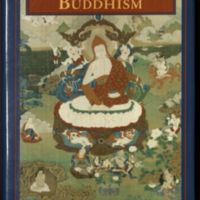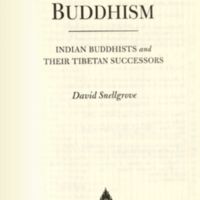Indo-Tibetan Buddhism: Indian Buddhists and their Tibetan successors
Dublin Core
Title
Indo-Tibetan Buddhism: Indian Buddhists and their Tibetan successors
Subject
Buddhism -- India -- History
Buddhism -- China -- Tibet Autonomous Region -- History
Buddhism -- Doctrines -- History
Buddhism -- China -- Tibet Autonomous Region -- History
Buddhism -- Doctrines -- History
Description
This authoritative and highly illustrated study concentrates on Buddhist philosophy and practice from the eighth to the thirteenth century, when the Tibetans were actively engaged in absorbing and importing Buddhist culture and religion from India. Snellgrove, a renowned Tibetan Buddhist scholar, emphasizes the significant role played by the Central Asian kingdoms along the ancient Silk Route in the gradual process of Tibetan conversion. Throughout, the author quotes extensively from original sources many of which have never before been translated into English.
Creator
David L. Snellgrove
Publisher
Boston : Shambhala
Date
2002
Table Of Contents
I. Origins in India -- 1. The Rediscovery of Indian Buddhism -- 2. Sakyamuni: Buddha of the Present World-Age -- 3. The Concepts of Samsara and Nirvana -- 4. The Preeminence of Buddhahood -- 5. The Buddhist Community -- II. Later Developments in India -- 1. Buddhism becomes a Pan-Asian Religion -- 2. The Buddha Image -- 3. Bodhisattvas -- 4. The Three Turnings of the Wheel of the Doctrine -- III. Tantric Buddhism -- 1. Connections with the more conventional Mahayana -- 2. The Vajrayana as a new and distinct "way" -- 3. Vajrapani (alias Vajradhara) becomes preeminent -- 4. Magical Formulas -- 5. The Votaries of the Tantras -- 6. Various Kinds of Tantras -- 7. Tantric Feasts -- 8. The Argument for Implicit Interpretations -- 9. The Importance of one's chosen Teacher -- 10. The Later Amalgamation and Promulgation of Tantric Teachings -- 11. Buddha-Families -- 12. The Mandala -- 13. Initiations and Consecrations -- 14. Further Consecrations -- 15. Special Concepts of Tantric Yogins -- IV. Buddhist Communities in India and Beyond -- 1. Traces of Buddhism in India -- 2. Traces of Buddhism in Central Asia -- 3. Buddhism in Nepal -- V. The Conversion of Tibet -- 1. Political and Social Factors -- 2. Religious Factors -- 3. The Combination of Politics and Religion.
Text Item Type Metadata
Original Format
Book
Citation
David L. Snellgrove, “Indo-Tibetan Buddhism: Indian Buddhists and their Tibetan successors,” Humanities Hub, accessed December 14, 2025, https://humanitieshub.sdsu.edu/omeka/items/show/1051.


